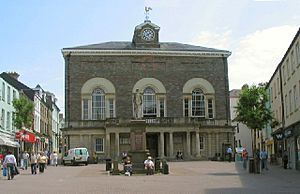Robert Taylor (architect) facts for kids
Quick facts for kids
Sir Robert Taylor
|
|
|---|---|

Carmarthen Guildhall by Sir Robert Taylor 1767–77
|
|
| Born | 1714 Woodford, Essex
|
| Died | 27 September 1788 |
| Nationality | English |
| Occupation | Architect |
| Buildings | Bank of England Heveningham Hall Gorhambury House |
Sir Robert Taylor (born 1714, died 1788) was a famous English architect and sculptor. He designed many important buildings across London and southern England.
Contents
Early Life and Artistic Beginnings
Robert Taylor was born in Woodford, Essex. He followed his father's path and began his career as a stonemason and sculptor. He learned from a well-known sculptor named Sir Henry Cheere.
Even though he created some important sculptures, like a bust of Christopher Emmott (a London merchant) and another of William Phipps, he didn't find much success as a sculptor. Because of this, he decided to focus on architecture instead.
A Busy Career in Architecture
One of Taylor's first big projects was Asgill House in Richmond upon Thames, built around 1760 for a rich banker, Sir Charles Asgill.
His connections helped him become the main architect for the Bank of England. He held this important job until he passed away, and then Sir John Soane took over. In 1769, he also became the Architect of the King's Works. This meant he was in charge of designing and maintaining royal buildings.
Many famous architects learned from Sir Robert Taylor, including John Nash, Samuel Pepys Cockerell, George Byfield, and William Pilkington.
In 1783, he was chosen to be a Sheriff of London. This was an important role in the city's government. He was also made a knight in the same year, which is why he is called "Sir" Robert Taylor.
Sir Robert was also a vice president for the Foundling Hospital. This was a special charity that helped children in London who had been abandoned.
Personal Life and Family
Sir Robert Taylor was married to Elizabeth, who passed away in 1803. They had a son named Michael Angelo Taylor (1757–1834). Their son grew up to become a politician. He was a Member of Parliament (MP) for Poole in the 1830s.
Sir Robert Taylor caught a cold at his friend Asgill's funeral in September 1788, which led to his death. Both he and his son were buried in the church of St Martin-in-the-Fields in Trafalgar Square, London. There is a special marble plaque in his honor on a wall in Westminster Abbey.
Lasting Legacy and Contributions
Sir Robert Taylor left a significant mark on education. The Taylor Institution at Oxford University is named after him. This center helps students learn about European languages and literature. He left money in his will to create a place for "teaching and improving the European languages."
There is also a group called the Sir Robert Taylor Society. This group brings together teachers of modern languages from schools and university professors from the Faculty of Medieval and Modern Languages, University of Oxford. They meet once a year to discuss literature, culture, and university admissions for different languages.
Notable Architectural Works
Sir Robert Taylor designed many buildings, some of which are still standing today. Here are a few examples:
- Asgill House, Richmond, Surrey (1761–64): A beautiful house built for a banker.
- Danson House, Bexley, Kent (1762–67): A grand country house.
- Bank of England, London (1765–87): He designed parts of this very important bank, including the Rotunda and the Court Room.
- Swinford Bridge, over the River Thames at Eynsham (1767–69): A bridge he designed.
- Maidenhead Bridge, Berkshire (1772–77): Another bridge he designed.
- Heveningham Hall (1777 – c. 1780): A large country estate.
- Gorhambury Manor, St Albans (1777–90): A stately home.
- Admiralty House, London (1786–88): A building in London.
- Salisbury Guildhall (1788–95): A public building in Salisbury, finished after his death by his student William Pilkington.
Some other works include:
- Alterations to 10 Downing Street, London SW1 (c. 1780): The famous home of the British Prime Minister.
Gallery of Architectural Work













